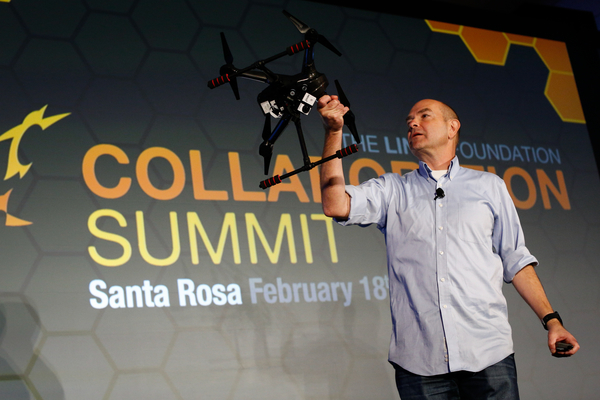
In 2007 former Wired Magazine Editor Chris Anderson built a Lego mindstorms robot with his kids in an effort to get them interested in science. Two years later he founded 3DRobotics, now the largest personal drone company in North America.
The initial toy wasn’t that interesting to his kids who were raised on Hollywood robots, he said in a keynote talk Wednesday at Collaboration Summit in Santa Rosa. So they undertook a more ambitious project to build a Lego autopilot and ended up building the first Lego drone – now in the Lego museum – at a time when drones were largely only built by the aerospace industry for military purposes.
“What we essentially did was weaponize Lego with my children around the dining room table,” Anderson said.
It was through this experience – building something he shouldn’t have been able to build on his own – that Anderson had a realization. The same market forces that enabled Lego mindstorms now represented an opportunity to disrupt an entire industry. While the aerospace industry was busy making military drones, no one was building commercial drones for consumer use, he said.
“I got chills. And the last time I got chills was the first time I used the Web,” Anderson said.
But what were the forces enabling a geeky dad to build a drone with off-the-shelf components? The growing smartphone market was making mobile components including MEMS sensors, ARM processors, GPS, camera sensors, wireless modules, and batteries, more accessible and affordable. At the same time, the DIY and maker communities were taking off — sharing ideas and open source hardware designs online.
In short, “hardware was starting to look like software,” Anderson said.
The combination of open innovation and accessible components created an enormous opportunity and 3D Robotics has blazed the trail to a new commercial drone industry. The startup now has venture capital backing and around 200 employees.
Drone technology has also reached a maturity level that the embedded Linux, ROS (Robot Operating System) and drone communities are converging, Anderson said. Dronecode, a Linux Foundation Collaborative Project, is designed to bring these various communities together to work on a common open source platform for Unmanned Aerial Vehicle (UAV) technology.
“We’re the Android in our industry,” Anderson said. They’re taking on competitors not with their software or their hardware, but with their openness.
The Dronecode project includes contributions from companies such as Intel and Qualcomm, which are innovating in ways that 3DRobotics couldn’t on its own, Anderson said. And companies like Google and Amazon are using the platform as the basis for their own drone projects.
“Drones aren’t just drones anymore,” said Anderson who envisions a cloud of autonomous sensors in the sky, collecting information and effectively digitizing the physical world. “Drones are sensors in the sky. Drones are big data. Drones are ways to send the Internet into the skies.”

